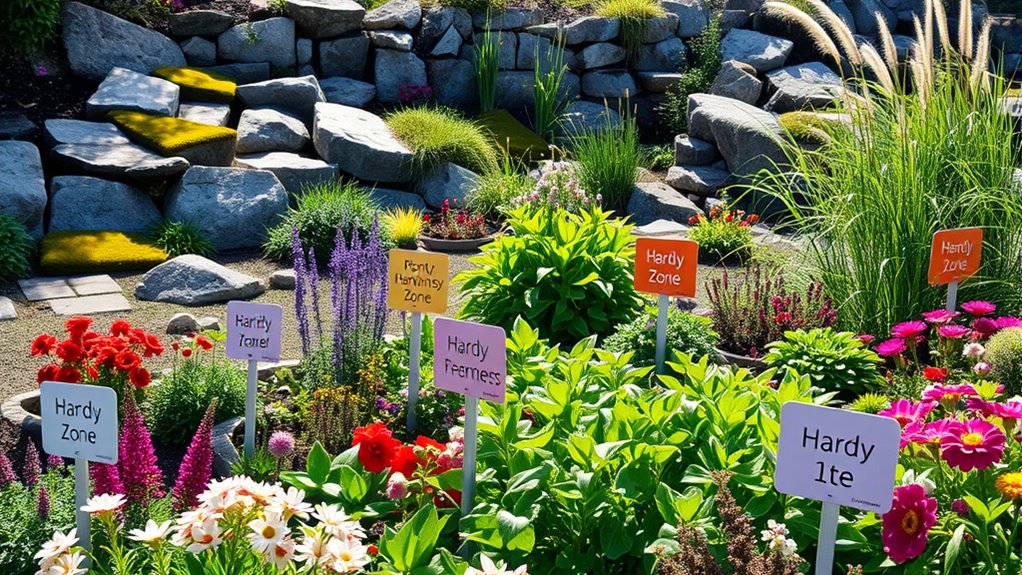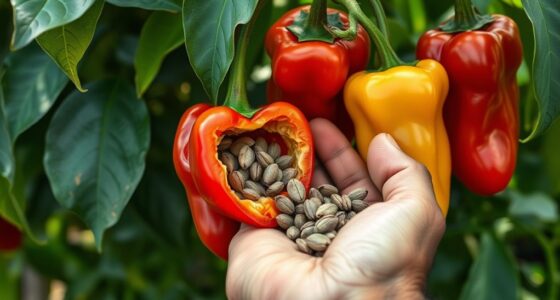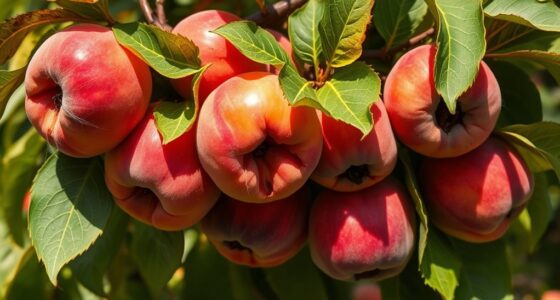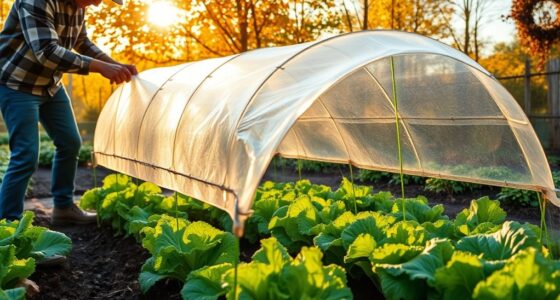Understanding your area’s plant hardiness zones helps you choose plants that can survive winter lows, making gardening more successful. Microclimates—small pockets with different temperatures or conditions—allow you to extend your growing season and protect plants from harsh weather. By knowing these factors, you can better position your plants and create a resilient garden. Continue exploring these concepts to unleash personalized tips for thriving in your specific environment.
Key Takeaways
- Plant hardiness zones indicate the coldest temperatures an area experiences, guiding plant selection for durability.
- Microclimates are localized climate variations within a garden, affecting plant survival and growth conditions.
- Understanding seasonal climate changes helps adjust planting schedules and protect plants from frost or heat.
- Recognizing microclimates allows for strategic plant placement to extend growing seasons and reduce frost risk.
- Native plants thrive best when matched to the specific hardiness zone and microclimate, ensuring healthier, sustainable gardens.
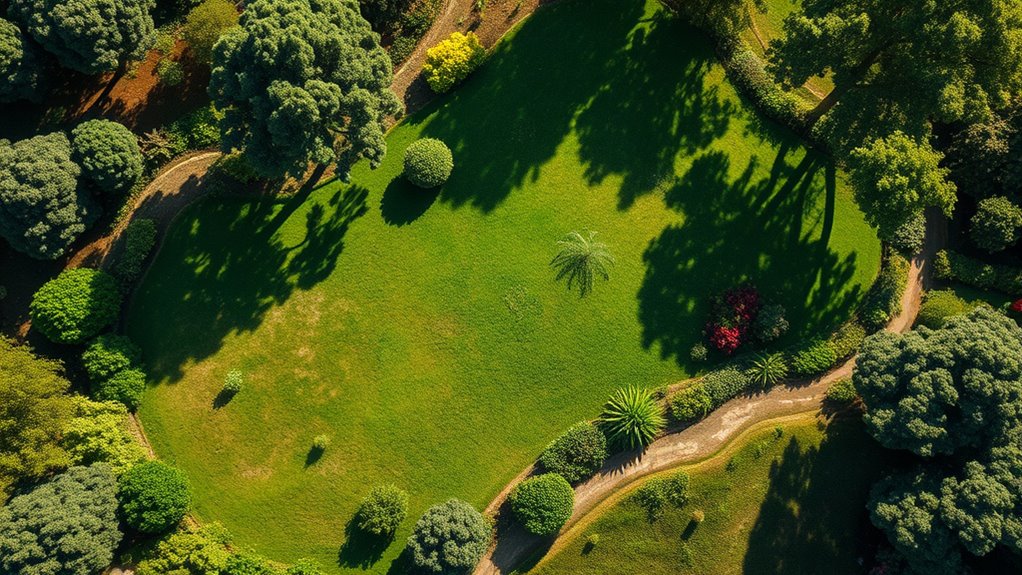
Understanding plant hardiness zones and microclimates is essential for successful gardening, especially if you want your plants to thrive. When you grasp how these factors influence your garden, you can make smarter choices about which plants to include and where to place them. Plant hardiness zones are based on the average minimum winter temperatures in your area. Knowing your zone helps you select plants that can survive the coldest conditions without extra protection. It’s a simple yet powerful tool to prevent disappointment and ensure your garden’s longevity.
Microclimates add another layer of complexity, but understanding them can markedly improve your gardening results. These tiny pockets of different climate conditions exist within your garden, influenced by factors like nearby buildings, pavement, water features, or shade trees. For example, a south-facing wall might trap heat and create a warmer microclimate, allowing you to grow plants that normally wouldn’t tolerate your region’s typical temperatures. Recognizing these variations helps you optimize plant placement, ensuring they get the right amount of sun, moisture, and warmth. Additionally, awareness of local climate variations can help you make more informed decisions about planting schedules and protective measures. Understanding microclimate effects can also help you better anticipate and respond to unexpected weather changes throughout the growing season.
Seasonal climate variations also play an essential role. Even within your hardiness zone, weather patterns can shift from year to year. A particularly harsh winter or an unusually warm spring can affect plant survival and growth. By paying close attention to seasonal trends, you can adjust your plant choices accordingly. For instance, if your area experiences late frosts, you might delay planting tender perennials or start seedlings indoors. Conversely, if you notice early springs or extended warm periods, you can take advantage of the climate window to grow plants that typically need longer growing seasons. Understanding local weather patterns can help you plan more effectively and reduce the risk of crop loss. Additionally, considering microclimate conditions can help you create more resilient planting strategies tailored to your specific environment.
Additionally, understanding your microclimate can help you mitigate frost risks by choosing optimal locations for sensitive plants, thereby extending your growing season and enhancing plant health. When selecting native plants, understanding your specific climate conditions becomes even more critical. Native plants are adapted to your region’s seasonal variations and microclimates, making them more likely to thrive with less maintenance. They often require less water, fewer fertilizers, and are more resistant to pests and diseases common in your area. By choosing native plant species suited to your zone and microclimate, you set your garden up for success, creating a resilient and sustainable landscape.
Frequently Asked Questions
How Do I Determine My Specific Microclimate Within My Zone?
To determine your specific microclimate, start with microclimate mapping of your area. Observe variations like shaded spots or sheltered areas that differ from general zone temperatures. Use local temperature monitoring tools—like a digital thermometer or weather station—to track temperature fluctuations throughout the day. Combining these observations with microclimate mapping helps you identify unique conditions in your yard, guiding better plant placement and care tailored to your microclimate.
Can Plants Survive Outside Their Designated Hardiness Zone?
Think of plant survival as a dancer on a stage; sometimes, they can adapt to different rhythms beyond their usual tune. While many plants thrive in their designated zone, some display zone flexibility, enduring outside their typical range. However, pushing boundaries risks their health. To guarantee success, research specific varieties and consider microclimates, giving your plants the best chance to flourish wherever you plant them.
How Do Climate Changes Affect Plant Hardiness Zones?
Climate impact causes zone shifts, meaning your local plant hardiness zones may change over time. As temperatures rise, areas once too cold become suitable for more plants, while colder zones shrink. You should stay updated on these zone shifts, as they influence which plants thrive in your garden. Being aware of climate change helps you select plants that will survive and flourish as environmental conditions evolve.
Are There Tools to Help Predict Microclimate Variations?
You might think predicting microclimate variations is tough, but tools like satellite imagery and climate modeling prove otherwise. These tools analyze temperature, humidity, and sunlight patterns, helping you identify microclimates in your area. Satellite imagery offers real-time visuals, while climate modeling predicts future changes. Together, they give you a powerful way to understand your local environment, allowing you to select plants best suited for your microclimate.
How Often Do Hardiness Zones Get Updated or Revised?
Zone updates occur roughly every 10 years, but revision frequency can vary depending on climate data accuracy and regional changes. You should check for updates from sources like the USDA, as they periodically revise zone maps to reflect evolving climate conditions. Staying informed guarantees your gardening plans align with current zone classifications, helping you select plants suited for your area’s latest hardiness zone.
Conclusion
So, next time you plant that delicate fern or stubborn tomato, remember—your garden’s a wild playground of microclimates and hardiness zones. It’s like trying to teach a penguin to thrive in the Sahara. Embrace the quirks, adjust your expectations, and maybe, just maybe, your plants will thank you for not turning your backyard into a botanical battlefield. After all, nature’s got its own sense of humor—sometimes, it’s downright hilarious.

